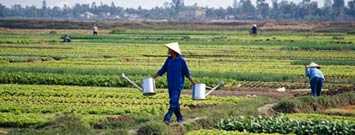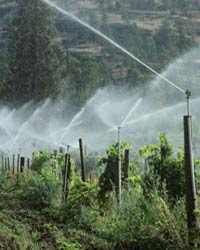NOTICE: This web page has been archived for historical purposes. Its content is no longer maintained, so information may be out of date and links may not work properly. For current Healthy Water features, please see the Newsroom, Features, & Observances page.
Learn about World Water Day 2012
 Learn about the 2012 World Water Day theme, "Water and Food Security: The World is Thirsty Because We are Hungry," which focuses on the close link between water use and food production.
Learn about the 2012 World Water Day theme, "Water and Food Security: The World is Thirsty Because We are Hungry," which focuses on the close link between water use and food production.
World Water Day 2012
Each year on March 22nd, World Water Day attracts international attention to the conservation and development of freshwater resources.
 Did you know that it takes one thousand times more water to feed a person than it takes to satisfy their thirst? While the average person drinks about 2.5 liters of water a day, producing just 2.2lbs of beef (1 kilo) requires 15,000 liters of water. Food production accounts for 70% of all water use, more than the amount needed for domestic and industrial use combined.
Did you know that it takes one thousand times more water to feed a person than it takes to satisfy their thirst? While the average person drinks about 2.5 liters of water a day, producing just 2.2lbs of beef (1 kilo) requires 15,000 liters of water. Food production accounts for 70% of all water use, more than the amount needed for domestic and industrial use combined.
As the world population continues to grow at a rapid pace, the demand for freshwater needed for food production will continue to increase, putting a strain on this invaluable resource. Each and every person can address this critical issue by learning what steps they can take to help preserve our freshwater resources, including:
- Learn how much water is used to make the foods we eat every day and consume less water-intensive products.
- Be mindful of food waste â 30% of all food produced worldwide is never consumed.
- Encourage food producers to use less water in their food.
For more information on World Water Day and ideas on how to get involved, visit the United Nations' World Water Day website.
CDC's Global Water, Sanitation, and Hygiene (WASH) Expertise
Inadequate water, sanitation, and hygiene (WASH) conditions exist in a range of settings, from temporary refugee camps to permanent homes in large cities.
 Since 1990, the number of persons able to access improved drinking water and sanitation resources has increased by 2 billion and 1.8 billion respectively (1). Despite these gains, hundreds of millions still lack access to these essential resources (1).
Since 1990, the number of persons able to access improved drinking water and sanitation resources has increased by 2 billion and 1.8 billion respectively (1). Despite these gains, hundreds of millions still lack access to these essential resources (1).
CDC's global WASH program provides expertise and interventions aimed at saving lives and reducing illness by improving global access to healthy and safe water, adequate sanitation, and improved hygiene. The WASH program works on long-term prevention and control measures for improving health, reducing poverty, and improving socioeconomic development as well as responding to global emergencies and outbreaks of life-threatening illnesses. These improvements reduce the lethal impact of WASH-related diseases ranging from cholera to typhoid fever to hepatitis.
For more information on CDC's Global WASH Program, visit the Global WASH website.
More Information
- World Water Day
- CDC's Global Water, Sanitation, and Hygiene Website
- CDC's Safe Water System
- CDC's Environmental Health Global Water, Sanitation, and Hygiene Website
- CDC's Global Disease Detection and Emergency Response Website
- CDC and the U.S. Global Health Initiative
- CDC's Healthy Water Website
Reference
- United Nations Children's Fund (UNICEF), World Health Organization. Progress on drinking water and sanitation: 2012 update. New York, NY: UNICEF, World Health Organization.
CDC works 24/7 saving lives and protecting people from health threats to have a more secure nation. A US federal agency, CDC helps make the healthy choice the easy choice by putting science and prevention into action. CDC works to help people live longer, healthier and more productive lives.
Get email updates
To receive email updates about this page, enter your email address:
Contact Us:
- Centers for Disease Control and Prevention
1600 Clifton Rd
Atlanta, GA 30333 - 800-CDC-INFO
(800-232-4636)
TTY: (888) 232-6348 - Contact CDC–INFO
 ShareCompartir
ShareCompartir


